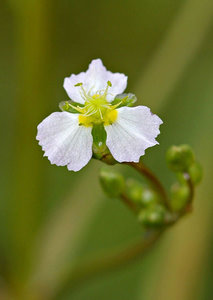
Pinyin: Ze Xie Latin: Alisma Plantago-Aquatica
Physical Characteristics:
Alisma Plantago Aquatica (Alismatis Root, Alisma orientale) is a perennial growing to 0.9m by 0.45m, hardy to zone 6. Alisma is in flower from June to August, and the seeds ripen from July to September. The flowers are hermaphrodite (have both male and female organs) and are pollinated by Flies.
The plant prefers light (sandy), medium (loamy) and heavy (clay) acid, neutral and basic (alkaline) soils. and cannot grow in the shade. Alisma requires wet soil and can grow in water.
Family:
Edible Uses:*
Edible Parts: Leaves; Root.*
Alisma Root is used cooked[13, 46, 61, 74]. Rich in starch[114]. Caution is advised, the root is acrid if it is not dried or well cooked before use[2, 183]. Alisma leaves and petioles - must be thoroughly cooked. They require long boiling and have a salty flavour[105, 179].*
Traditional Chinese Medicinal (TCM) Uses:*
The leaves are antibacterial, anticholesterolemic, diaphoretic, diuretic, hypoglycaemic and hypotensive[4, 147, 176].*
Alisma Plantago Aquatica leaves are used in the treatment of cystitis, dysentery, renal calculus, gravel etc[4].*
The fresh Alisma leaf is rubefacient[222], is used in the treatment of leprosy[218] and is also applied locally to bruises and swellings[4]. Dried Alisma stem bases are eaten, or grated and taken with water in treating digestive disorders such as heartburn, cramps and stomach flu[257]. The powdered seed is an astringent, used in cases of bleeding[4].*
The Alisma seed is also said to promote sterility[218]. The root contains an essential oil and has a wide range of medicinal uses[176, 218, 283]. Alisma root is antibacterial, anticholesterolemic, diuretic and hypotensive[176]. Alisma root is said to lower blood pressure, cholesterol and blood sugar levels[238] whilst it also has an antibacterial action on Staphylococcus, Pneumococci and Mycobacterium[176].*
Alisma root is used in the treatment of oliguria, oedema, nephritis, acute diarrhoea, cholesterolaemia and fatty liver[176]. Alisma has been thought of as a cure for rabies, though this has not been substantiated[4]. The whole plant is believed to promote conception[218]. The root is harvested before the plant comes into flower and is dried for later use[238]. A homeopathic remedy is obtained from the fresh root[4].*
References:
- [K] Ken Fern
- [1] F. Chittendon.RHS Dictionary of Plants plus Supplement. 1956 Oxford University Press 1951
- [2] Hedrick. U. P.Sturtevant's Edible Plants of the World. Dover Publications 1972 ISBN 0-486-20459-6
- [4] Grieve.A Modern Herbal. Penguin 1984 ISBN 0-14-046-440-9
- [13] Triska. Dr.Hamlyn Encyclopaedia of Plants. Hamlyn 1975 ISBN 0-600-33545-3
- [17] Clapham, Tootin and Warburg.Flora of the British Isles. Cambridge University Press 1962
- [24] Baines. C.Making a Wildlife Garden. 0
- [46] Uphof. J. C. Th.Dictionary of Economic Plants. Weinheim 1959
- [56] Muhlberg. H.Complete Guide to Water Plants. E. P. Publishing Ltd. 1982 ISBN 0-7158-0789-7
- [61] Usher. G.A Dictionary of Plants Used by Man. Constable 1974 ISBN 0094579202
- [74] Komarov. V. L.Flora of the USSR. Israel Program for Scientific Translation 1968
- [105] Tanaka. T.Tanaka's Cyclopaedia of Edible Plants of the World. Keigaku Publishing 1976
- [114] Chakravarty. H. L.The Plant Wealth of Iraq. 0
- [147] A Barefoot Doctors Manual. Running Press 0 ISBN 0-914294-92-X
- [176] Yeung. Him-Che.Handbook of Chinese Herbs and Formulas. Institute of Chinese Medicine, Los Angeles 1985
- [179] Reid. B. E.Famine Foods of the Chiu-Huang Pen-ts'ao. Taipei. Southern Materials Centre 1977
- [183] Facciola. S.Cornucopia - A Source Book of Edible Plants. Kampong Publications 1990 ISBN 0-9628087-0-9
- [200] Huxley. A.The New RHS Dictionary of Gardening. 1992. MacMillan Press 1992 ISBN 0-333-47494-5
- [218] Duke. J. A. and Ayensu. E. S.Medicinal Plants of China Reference Publications, Inc. 1985 ISBN 0-917256-20-4
- [222] Foster. S. & Duke. J. A.A Field Guide to Medicinal Plants. Eastern and Central N. America. Houghton Mifflin Co. 1990 ISBN 0395467225
- [238] Bown. D.Encyclopaedia of Herbs and their Uses. Dorling Kindersley, London. 1995 ISBN 0-7513-020-31
- [257] Moerman. D.Native American Ethnobotany Timber Press. Oregon. 1998 ISBN 0-88192-453-9
- [283] Nguyen Van Dan & Doan Thi NhuMedicinal Plants in Vietnam World Health Organisation 1989 ISBN 92 9061 101 4
Source: Alisma Plantago Aquatica Plants For A Future, England 1996-2008.
This work is licensed under a Creative Commons License.
Natural dietary supplements are designed to offer the body support to promote health, harmony, balance and overall well being.*

 Get Well Natural, LLC
Get Well Natural, LLC  Kidney Function & Regeneration Health
Kidney Function & Regeneration Health  Platelet & Blood Cell Health
Platelet & Blood Cell Health  Prostate, Flow & Function Health
Prostate, Flow & Function Health  General Mind & Body Health
General Mind & Body Health  Heart, Cholesterol & Cardio Health
Heart, Cholesterol & Cardio Health  Allergy-Free Body
Allergy-Free Body  Anxiety & Stress
Anxiety & Stress  Blood Platelet Counts & Function
Blood Platelet Counts & Function  Blood Pressure Health
Blood Pressure Health  Kidney Function Health
Kidney Function Health  Immune System Health & Balance
Immune System Health & Balance  Prostate & Urinary Health Function
Prostate & Urinary Health Function  Blood Sugar Balance
Blood Sugar Balance  Cardiovascular Heart Health
Cardiovascular Heart Health  Detoxification & Healthy Cells
Detoxification & Healthy Cells  Women's Health
Women's Health  Liver Regeneration
Liver Regeneration  Pain-Free Body
Pain-Free Body  Water & Air Filtration
Water & Air Filtration 


